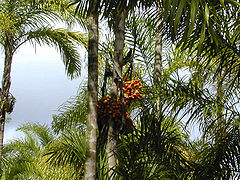Bactris
| Bactris subsp. var. | ||||||||||||||||||||||||||||||||||||||||||||||||||||||||
|---|---|---|---|---|---|---|---|---|---|---|---|---|---|---|---|---|---|---|---|---|---|---|---|---|---|---|---|---|---|---|---|---|---|---|---|---|---|---|---|---|---|---|---|---|---|---|---|---|---|---|---|---|---|---|---|---|

|
|
| ||||||||||||||||||||||||||||||||||||||||||||||||||||||
| ||||||||||||||||||||||||||||||||||||||||||||||||||||||||
Bactris is a genus of about 240 species in the palm family, Arecaceae, native to Central and South America, and the Caribbean. They are trees growing to 4-20 m tall. The leaves are up to 5 m long, and pinnate with numerous leaflets. The fruit is a drupe, 2-6 cm long, edible in some species.
| Standard Cyclopedia of Horticulture |
|---|
|
Bactris (Greek, baktron, cane; the young stems used for walking-sticks). Palmaceae, tribe Bactrideae. Usually low palms, very rarely entirely spineless. Stems solitary or fasciculate, ringed, spiny or smooth, sprouting from the roots: Lvs. terminal or scattering, equally or unequally pinnatisect, glabrous or pubescent; segms. sparse or aggregated, or more or less imperfectly connate, forming a bind blade, acute or rarely obtuse at the apex, the ciliate margins recurved at the base; petiole short or long; sheath long, spiny: spadices sessile or pedunculate, perforating the lf.- sheaths; spathes 2, the lower short,, open at the apex, the upper coriaceous or woody, exceeding the spadix, or fusiform, ventrally dehiscent, smooth, bristly or spiny; bracts persistent: fls. small or medium, pale yellow or greenish: fr. small, green, ovoid or globose.— Species 90. Trop. Amer. These are ornamental palms, but little grown on account of the spines. The fruits of B. major are used extensively in South America for food. The cultivation of bactris is easy if it is grown in a warmhouse, with a range of temperature from 60° to 80°, and given plenty of water. Frequent syringing is advisable. It thrives best in a mixture of loam, two parts; leaf-mold, one part; well-rotted cow-manure, one part. The young plants are very decorative, but in age most of the species become spindly. Propagation is by suckers which grow freely; rarely by seeds, which are hard to get. B. aurantiaca, Hon., is a "pinnate palm from Mex., dwarf and spiny but beautiful." The name is unknown in botanical literature. —B. caryotaefolia. Mart., from Brazil, with wedge-shaped 3-lobed pinnae, has been catalogued; also B. utilis, Benth. & Hook. (Guilieima utilis, Oerst.), from Costa Rica, with spiny petioles and young lvs.
|
Cultivation
Propagation
Seed.
Pests and diseases
Species
- Selected species
- Bactris acanthocarpa
- Bactris bifida
- Bactris brogniartii
- Bactris coloniata
- Bactris constanciae
- Bactris cruegeriana
- Bactris cubensis
- Bactris ferruginea
- Bactris gasipaes (Pupunha)
- Bactris guineensis
- Bactris glandulosa
- Bactris glaucescens
- Bactris gracilior
- Bactris grayumi
- Bactris hirta
- Bactris jamaicana
- Bactris longiseta (Huiscoyol)
- Bactris major
- Bactris mexicana
- Bactris militaris
- Bactris nancibensis
- Bactris pickelii
- Bactris pilosa
- Bactris plumeriana
- Bactris setiflora
- Bactris setosa
- Bactris simplicifrons
- Bactris wendlandiana
Gallery
-
photo 1
-
photo 2
-
photo 3
References
- Standard Cyclopedia of Horticulture, by L. H. Bailey, MacMillan Co., 1963
External links
- w:Bactris. Some of the material on this page may be from Wikipedia, under the Creative Commons license.
- Bactris QR Code (Size 50, 100, 200, 500)
